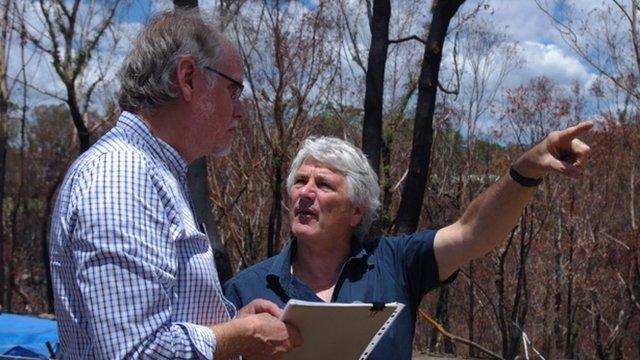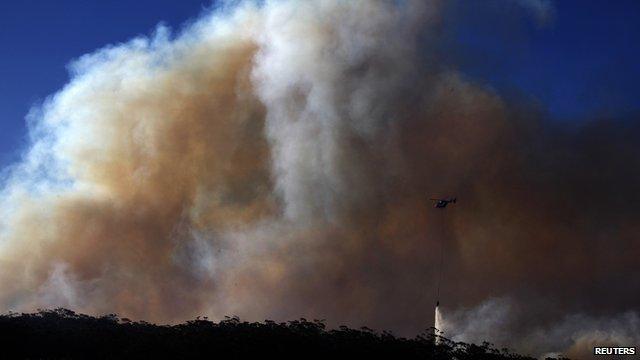Rebuilding lives after Australia bushfires
- Published
Architect Nigel Bell explains how to build a fire-safe home
Among the contorted metal and charred remains of what were once proud family homes, tiny green shoots are starting to emerge from the blackened soil of the fire-hit Blue Mountains in eastern Australia.
In October, three large blazes devoured vast areas of bush land west of Sydney, and only an unprecedented firefighting effort prevented outright catastrophe. More than 200 houses were razed.
But once the initial trauma had eased, many of those affected began to dream of a fresh start and to rebuild on familiar ground.
Ron Fuller lost almost everything when the fires came; a prized Aboriginal art collection, family photographs and a well-loved garden are gone.
His property at Winmalee was no match for the inferno that raced through.

Razed ground now marks the spot where Ron Fuller's house once stood
Mercifully no one was home when disaster struck.
"This street lost about 20 houses, and it hit here very quickly and when it did hit there were no fire trucks here. So there was nobody able to stop it and it raced down one side of the street," Ron explains, standing in the middle of what was once his living room.
A few metres away, an excavator grabs another mechanical hand of debris, which is sent clattering into the back of waiting lorry.
Other residents complain that it has taken the state government far too long to allow fire-damaged land to be cleared because of contamination fears over asbestos and arsenic.
Strict regulations also mean that, for many, insurance payouts won't cover the higher costs of rebuilding in such a combustible region.
Most homeowners will return and begin anew because of necessity and romance.
"First of all, economically you've got no choice," said Mr Fuller, a retired journalist.
"Who is going to buy a block of land like this? So there is no point putting it on the market. You are going to get nothing for it, so you are locked in to building.
"Then comes the other emotional attachment to this area. We love this area," he said.
Eco-friendly housing
A short drive down the mountains past swathes of scorched bush land, with its ghastly copper hue, the next generation of fire-resistant homes is being built in the township of Glenbrook.
It's a formidable mix of toughened glass, concrete, hardwood and steel, according to architect Nigel Bell, who specialises in ecologically sensitive designs.

Architect Nigel Bell and Ron Fuller discuss the rebuilding of a new house on the site of damaged land
"Most of the outside of the house is totally non-combustible," he explains.
"We have a range of different metals. Behind us we can see what is known as corten, which is a brass-rich steel, so obviously that is highly fire-resistant.
"We have corrugated metals, which are inexpensive and obviously fire-resistant.
"Where we do have timbers, we have it recycled from this building site. Turpentine timber (is) very hard to ignite," he said.
New South Wales has some of Australia's most stringent building codes for bushfire zones.
But even properties fortified by the latest that science and design has to offer cannot offer total protection.
"Even if you spend a considerable amount of additional money there is still no guarantee you'll be completely safe," Nigel Bell adds.
Managing risks
Wild fires are common across Australia, the world's driest inhabited continent.

Helicopters were used to try and douse the fires but in future they might not be enough
The way they burn is determined by three central factors:- the amount of fuel on the ground, such as trees, grass and leaf-litter; the weather and topography, or the shape of the land.
Phil Koperberg, who is coordinating the official bushfire recovery programme in the Blue Mountains, told the BBC that there would be more dangerous times ahead.
"Things are changing. The climate is getting drier and we are experiencing more extreme fire days than we might have 15 or 20 years ago. There is a severe rainfall deficit in the mountains.
"Climate change - in whatever ways it manifests itself - will result in more days that make us, as communities, susceptible to natural disasters," he said.
"It is a question of managing those risks (and) not simply hopping on a boat and sailing away," he added.
The recovery effort isn't just about rebuilding homes. Restoring confidence and trying to re-establish a sense of security for those living in the fire zone are crucial.
There is a distinct sense here that the community will emerge stronger from its bushfire ordeal and be better prepared for what nature may unleash in the future as Australia prepares for what could be a long, hot summer.
- Published24 October 2013
- Published23 October 2013
- Published23 October 2013
- Published23 October 2013
- Published23 October 2013
- Published23 October 2013
- Published21 October 2013